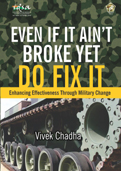You are here
Even If It Ain’t Broke Yet, Do Fix It: Enhancing Effectiveness Through Military Change

About the Book
Bringing about change in any setup, especially major shifts, is a challenge. This challenge is accentuated further in a strictly hierarchical organisation like the army, presenting an unenviable contradiction to both senior military practitioner and the governing elite, wherein, change is inevitable, yet, it is most likely to be resisted.
Military change is a relatively nascent area of study, especially in the Indian scenario. This book attempts to analyse this subject through an examination of existing literature, thereby co-relating some of its primary conclusion in the context of the Indian Army. This is done in relation to both conventional and sub-conventional threats and challenges, with a number of case studies as illustrative examples.
The book concludes that given the wide spectrum of threats faced by the Indian Army, as also most major armies across the world, attempts at understanding military change only through the prism of conventional wars could be misleading. It suggests that change need not only be revolutionary to enhance effectiveness. It could be both revolutionary and evolutionary, top-down and bottom-up. While effective change is primarily major in conventional conditions, it could well be tactical and yet make a substantial impact in sub-conventional scenarios. The book reinforces the importance of operational changes in the sub-conventional domain, even as an assessment of strategic and organisational changes is undertaken. It attempts to answer important questions related to the drivers, shapers, facilitating conditions and limitations related to effective change. It also relates military change with organisational change in the corporate world to provide an interesting comparative analysis. Finally, the book reinforces its conclusions through a survey of officers from the Indian Army, to highlight existing limitations that need to be corrected in order to better innovate and adapt in pursuit of effective military change.
About the Author
Colonel Vivek Chadha (Retd) served in the army for over 22 years before joining IDSA in 2011, as a Research Fellow, His areas of research include defence studies, counter insurgency and terrorism finance. His published books include, Lifeblood of Terrorism: Countering Terrorism Finance, Low Intensity conflicts in India: An Analysis and Indo-US Relations: Divergence to Convergence. He has also edited, Armed Forces Special Powers Act: the Debate. He is on the editorial board of the Journal of Defence Studies
CONTENTS
Acknowledgements
List of Tables and Charts
Introduction
- Existing Theoretical Frameworks
What is Military Change?
Why Do Militaries Change? - An Assessment of Organisational Change
Changes Post 1962 Sino-Indian War
Reforms Post K.V. Krishna Rao Report - Strategic Military Change
Changes after the 1962 Sino-Indian War
Changes Post 1975 Krishna Rao Recommendations
Cold Start or Limited Pre-emptive Offensive - Assessment of Military Change in a Conventional Environment
Drivers of Military Change Pathways of Military Change
Desirables for Successful Change
Long-term Strategic Assessment
Support from Political Establishment
Visionary and Committed Military Leadership
Strong Institutional Structures
Follow-up Action - Change in Military Strategy
Frontier Warfare
CI Operations in the Mid-fifties and Early Sixties
CI Operations from Mid-sixties till the Seventies
Iron Fist and Velvet Glove Strategy
Major Increase in Force Levels
Change in Legal Provisions
LoC Obstacle System
Use of Local Militia
Use of Offensive Air Support
Change in Goals - Organisational Change
Creation of Ad Hoc Rifle Company
Rashtriya Rifle Battalions
Army Commander Special Financial Powers
Commando Platoon - Change in Conduct of Operations
Changes in Conduct of Operations
Training
Readjustment of Battalions
Strengthening and Buffering Vehicles
Use of Captured Equipment
Modification of SLR
Technology-driven Changes
Night-vision and Surveillance Devices
Creation and Deployment of Ashi Pillai - Army’s Ability to Cope with Change
Type of Change
Approach to Change and Its Manifestation
Drivers of Change
Impact of Military Change
Source of Influence
Quality of Change
Speed of Implementation
Constraints of Military Change
Applicability of Military Change to Specific Regions
Conclusion - Contextualising Military Change
Relating Lessons from the Corporate World
Does Existing Theory Explain Military Change?
Drivers of Military Change
Who Drives Military Change?
Pathways to Military Change
Direction of Military Change
Scale of Change
Level of Change
Type of Change - Concluding Observations
Annexures
1. Illustration of Military Change in Counterinsurgency (CI) Operations
2. Region-wise Assessment of Military Change
PART I
CONVENTIONAL THREATS
Military Change in the Indian Army: Case of External Threats
PART II
MILITARY CHANGE IN COUNTERINSURGENCY
Adaptation to Change
PART III
ANALYSING MILITARY CHANGE
Index
View discussion on the book
Order Hard Copy
Please email us at adps.idsa [at] nic.in or call +91-11-2671 7983 (Ext. 7303)


